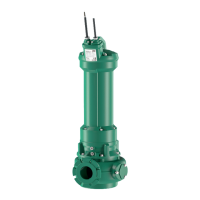Installation and electrical connection en
Installation and operating instructions Wilo Motor T 17.3, 20.2:, EMU FA, Rexa SUPRA, Rexa SOLID 65
CAUTION
Permanent magnet motors: Connection wire may be live!
Turning the rotor may mean a voltage applies at the connection wires. Insulate con-
nection wires and do not short circuit!
CAUTION
Total damage due to moisture ingress
The ingress of moisture into the connection cable damages the cable and the pump!
Never immerse the ends of the connection cable in fluid. Seal them tightly during
storage.
Newly delivered pumps can be stored for one year. Contact customer service before
storing the device for more than one year.
When storing the pump, please note the following points:
ƒ Place the pump upright (vertical) on a firm bearing surface. Secure the pump against
falling over and slipping!
ƒ The max. storage temperature is -15°C to +60°C (5°F to 140°F). The max. relative
humidity is 90%, non-condensing. We recommend frost-proof storage. Ambient
temperature: 5 to 25°C (41 to 77°F), relative humidity: 40 to 50%.
ƒ Do not store the pump in rooms in which welding work is carried out. The resulting
gases or radiation can corrode the elastomer parts and coatings.
ƒ Seal the suction and pressure connection tightly.
ƒ Protect the connection cable against kinking and damage. Maintain a constant bend
radius!
ƒ Impellers must be turned by 180° at regular intervals (3–6months). This prevents
the bearings from jamming and renews the lubrication film on the mechanical seal.
WARNING!There is a risk of injury due to sharp edges on the impeller and suction
port!
ƒ Elastomer parts and the coating are subject to natural brittleness. Contact customer
service if the mixer has to be stored for more than 6months.
After storage, remove any dust and oil from the pump and check the coating for dam-
age. Repair damaged coatings before further use.
6 Installation and electrical con-
nection
6.1 Personnel qualifications
ƒ Electrical work: A qualified electrician must carry out the electrical work.
ƒ Installation/dismantling: The technician must be trained in the use of the necessary
tools and fixation materials for the relevant construction site.
6.2 Installation types
ƒ Vertical stationary wet well installation
ƒ Vertical portable wet well installation
ƒ Vertical stationary dry well installation
The following installation types are not permitted:
ƒ Horizontal installation
6.3 Operator responsibilities
ƒ Observe locally applicable accident prevention and safety regulations of trade asso-
ciations.
ƒ Observe all regulations for working with heavy loads and under suspended loads.
ƒ Provide protective equipment and ensure that the protective equipment is worn by
personnel.
ƒ Observe local sewage technology regulations for the operation of sewage systems.
ƒ Avoid pressure surges!
Pressure surges can occur in long pressure pipes with steep terrain. These pressure
surges can lead to the destruction of the pump!
ƒ Ensure the cooling time of the motor depending on the operating conditions and the
size of the pump chamber.
ƒ Structural components and foundations must be of sufficient stability in order to al-
low the device to be fixed securely and functionally. The operator is responsible for
the provision and suitability of the structural component/foundation!

